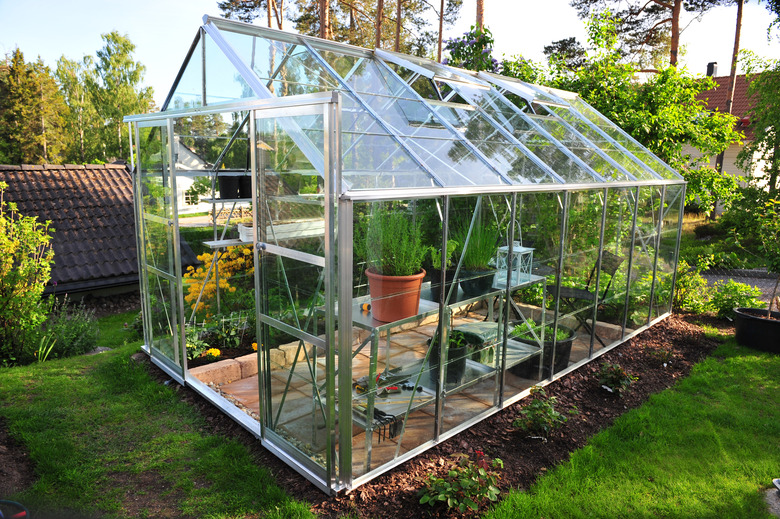What Direction Should A Greenhouse Face?
We may receive a commission on purchases made from links.
Greenhouses are a great solution to keep your garden thriving year-round. Before you start building, one of the most vital steps to consider when planning and building a greenhouse is its location and orientation to the sun. For greenhouses, sunlight is key, so you'll want to choose a spot with optimal sunlight to provide your plants with the best environment possible.
Tip
If you live in the Northern Hemisphere, your greenhouse should face south for the most optimal amount of sunlight. In the Southern Hemisphere, greenhouses should face north.
What Direction Should a Greenhouse Face?
What Direction Should a Greenhouse Face?
If you live in the United States or anywhere in the Northern Hemisphere, your greenhouse should face south or southeast. In general, this allows for your greenhouse to get the most amount of sunlight possible to keep plants warm and happy. As a rule of thumb, it's best to avoid facing your greenhouse toward the north (unless you live in the Southern Hemisphere) since it gets the least amount of sunlight on average. If you want to get really precise, you can create a sun chart path so you'll know the exact amount of sunlight that hits your proposed greenhouse location throughout the day to see if it adds up to at least six hours of light.
Though sunshine is essential in a greenhouse, too much can cause plants to become overheated and burn, especially if you live in an area with ample sun and little shade. When choosing a location for your greenhouse, sunlight ranks the highest on the priority list, but it's also beneficial for your plants to have shade, so a few trees or some foliage should be fine as long as they don't cast a huge shadow and entirely block the sunlight from getting to your plants.
Tip
In addition to building your greenhouse in a spot with lots of sunlight, consider building it close to a water and electricity source for easy access.
How to Control the Temperature in a Greenhouse
How to Control the Temperature in a Greenhouse
In addition to choosing the best direction for a greenhouse, you'll need to keep a consistent temperature inside. Both hot and cold temperatures require workarounds to ensure your plants aren't overheating or freezing.
When it comes to making sure your greenhouse doesn't get too hot, you'll want to set up a proper ventilation system to get warm air out and cool air in. You can do this by installing fans, windows, roll-up sides, or solar power vents. You can also use tarps or coverings to cool down temperatures, especially if your plants require some shade.
For locations that experience colder temperatures throughout the year, you'll need to invest in a heating system. There are many different heater options from which to choose, including generators and gas or electric heaters. Heating systems are also beneficial in warm-climate greenhouses, especially if temperatures tend to drop once the sun goes down.
Tip
If you live in an area that gets snow, make sure your greenhouse has a pitched roof to allow the snow to slide off instead of accumulating and potentially causing the top of your greenhouse to cave in.
What Materials Are Best for Building a Greenhouse?
What Materials Are Best for Building a Greenhouse?
Most greenhouses are built using a wood or metal frame and glass or transparent plastic sheets or panels for the siding to allow the most sunlight in. These popular siding choices also allow heat to seep in and keep plants warm.
Unlike traditional greenhouses, hoop houses are often called "mini greenhouses" and are built using a sheet of heavy plastic over a wire or plastic arch system. The most significant difference between a greenhouse and a hoop house is that a greenhouse has an installed heating and ventilation system, whereas a hoop house does not. While hoop houses tend to cost less to build than greenhouses, they require more monitoring to ensure plants are at a hospitable temperature.
References
- Today's Homeowner: Pro Tips for Gardening in a Greenhouse
- Today's Homeowner: How to Build a DIY Greenhouse for Your Yard
- Almanac: Is There a Greenhouse in Your Future?
- Green Building Advisor: Flatrock Passive: Essentials for a Winter Greenhouse
- Bob Vila: The Best Greenhouse Plastics for a Longer Growing Season
- Home Depot: How to Build a Greenhouse
- Texas A&M AgriLife Extension: Texas Master Gardener Tips for Hobby Greenhouse Owners
- Oklahoma State University Extension: The Hobby Greenhouse
- Chicago Botanic Garden: Five Reasons to Raise a Hoophouse
- New Mexico State University: Hoop House Vegetable Production
- NSW Government Department of Primary Industries: Orientation and Siting a Greenhouse
